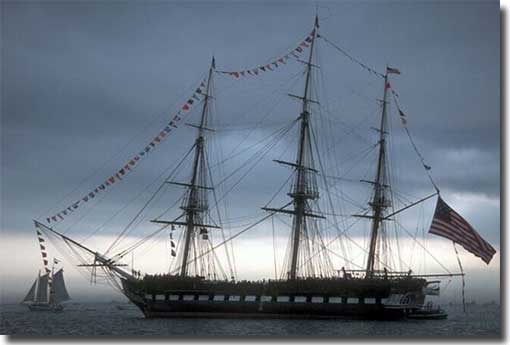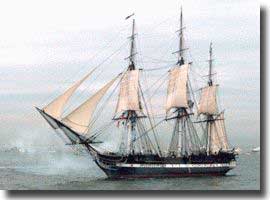|
Old Ironsides, USS Constitution
A three masted wooden hulled frigate, 204 feet in length, with a beam of 43.5 feet, carrying 44 guns and displacing 2,200 tons, and having a crew of 450, USS Constitution, was constructed by an act of Congress in 1794. Designed by Joshua Humphreys as one of six frigates, she was built at the Edward Hartt shipyard in Boston, from oak with her planks up to seven feet thick. It was Paul Revere who forged the copper sheathing for the hull, and the copper spikes used to fasten the oak planks in place.
USS Constitution in silhouette Captain Edward Preble in 1803 took Constitition as his flagship in the Mediterranean Squadron, and used her against the Barbary States of North Africa, they were demanding that the US pay for access of their Merchant ships to Mediterranean ports. An aggressive campaign was persued by Preble against Tripoli, and it paid off, when Tripoli, Tunisia, and Algiers all agreed to a peace treaty with the United States. Constitution spent two years off the coast of North Africa enforcing this treaty, then returned home to the US for a repair refit. In 1809, she became flagship of the North African Squadron with Commodore John Rogers leading this group. On the 20th. of June 1812, the US and Great Britain were at war, on the 17th. of July, off Egg Harbor, New Jersey, Constitution came upon five English ships, but managed to elude them. Then a month later she met up with the English Guerriere, and after a 20 minute fight this vessel was reduced to a wreck, dismasted and not worth salvaging. To the astonishment of the British, all their shot merely bounced harmlessly off the hull of Constitution, her thick oak planking preserving her from harm, thus giving the ship the nickname of "Old Ironsides". Later in December of 1812, another British Frigate Java met her fate in battle with Constitution. Before peace was finally declared in 1815, she had captured eight more British ships. Extensive repairs followed in the next six years before this ship once more became the Mediterranean flagship, and then in 1828 going home to Boston. 1830 found Constitution declared unfit for sea, and there was talk of sending the ship to the scrapyards, but a public outcry resulted at this suggestion, and Congress was forced to pass an appropriation for the ship to be reconstructed, and by 1835 was again in commission. She returned to her old beat in the Mediterranean as flagship, also serving in the South Pacific. 1844 saw the commencement of a 2.5 year world cruise. In the 1850's Constitution was again in service off the African coast, and in the American Civil War she was used as a training vessel for Midshipmen. Durable as always, the ship was once more refitted in 1871, but was decommissioned in 1882. 1897 was Constitution's centenary year, and she celebrated that milestone at home in Boston.
USS Constitition. Old Ironsides That dreadful word "SCRAPPING" was being bandied about in 1905, but again public sentiment saved her from that awful fate. In 1925 through donations from thousands of school children and patriotic groups the old ship was saved, and in 1931 she was re-commissioned, taken under tow for a 90 city/port tour along the Atlantic, Gulf, and Pacific coastline of the United States. During this odyssey of three years, some 4,600,000 people trod her decks on a visit to the old warhorse. Now very much a symbol and an American icon, USS Constitution came home to Boston. 1941 found this ship placed in permanent commission, then in 1954, an act of Congress gave the US Secretary of the Navy responsibility for her upkeep. We visit the Constitution in Boston.
LITTLE KNOWN TIDBIT OF NAVAL HISTORY ••• However, let it be noted that according to her ship's log, "On July 27,1798, the U.S.S. Constitution sailed from Boston with a full complement of 475 officers and men, 48,600 gallons of fresh water, 7,400 cannon shot, 11,600 pounds of black powder and 79,400 gallons of rum." Her mission: "To destroy and harass English shipping." Making Jamaica on 6 October, she took on 826 pounds of flour and 68,300 gallons of rum. Then she headed for the Azores, arriving there 12 November. She provisioned with 550 pounds of beef and M,300 gallons of Portuguese wine. On 18 November, she set sail for England .. In the ensuing days she defeated five British men-of-war and captured and scuttled 12 English merchant ships, salvaging onlv the rum aboard each. By 26 January, her powder and shot were exhausted. Nevertheless, although \ she made a night raid up The U. S. S. Constitution arrived in Boston on 20 February 1799, with no cannon shot, no food, no powder, no rum, no wine, no whisky and 38,600 gallons of water. |


